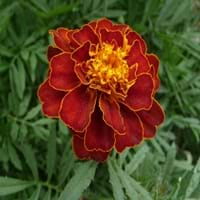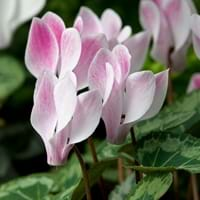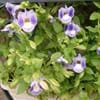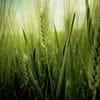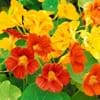Life Span
Annual
Perennial
Type
Flowering Plants, Shrubs
Flowering Plants, Tubers
Origin
Mexico, Central America
Europe, Mediterranean Basin, Middle East, North Africa, Somalia
Types
African or American Marigolds, French Marigolds, Mule Marigolds
Cyclamen Africanum, Cyclamen Alpinum, Cyclamen Cilicium, Cyclamen Coum
Habitat
Roadsides, wastelands
Alpine Meadows, Rocky areas, Woods
USDA Hardiness Zone
9-11
5-9
Sunset Zone
A1, A2, A3, H1, H2, 1a, 1b, 2a, 2b, 3a, 3b, 4, 5, 6, 7, 8, 9, 10, 11, 12, 13, 14, 15, 16, 17, 18, 19, 20, 21, 22, 23, 24
15, 16, 17, 18, 19, 20, 21, 22, 23, 24
Habit
Clump-Forming
Clump-Forming
Flower Color
Yellow, Red, Orange, Gold, Dark Red, Orange Red
Pink, Purple, White
Flower Color Modifier
Bicolor
Not Available
Leaf Color in Spring
Dark Green
Several shades of Green
Leaf Color in Summer
Dark Green
Not Available
Leaf Color in Fall
Dark Green, Burgundy
Green, Silver
Leaf Color in Winter
Light Green
Green, Silver
Leaf Shape
Toothed
Heart-shaped
Plant Season
Summer, Fall
Autumn, Spring, Summer, Winter
Sunlight
Full Sun
Indirect sunlight
Type of Soil
Loam, Sand
Clay, Sandy, Well drained
The pH of Soil
Acidic, Neutral, Alkaline
Acidic
Soil Drainage
Well drained
Well drained
Bloom Time
Early Summer, Summer, Late Summer, Early Fall, Fall, Late Fall
Autumn, Spring, Summer
Tolerances
Drought
Not Available
Where to Plant?
Container, Ground, Pot
Container, Ground, Pot
How to Plant?
Seedlings
From bulbs, Seedlings
Plant Maintenance
Medium
Medium
Watering Requirements
Allow soil to be completely dry in between waterings, Form a Soil ring to water efficiently, Keep the ground moist but not water-logged, Water in morning to avoid prompting diseases, Water when soil is dry
Do not water frequently, It cannot sustain wet-feet, Keep the ground moist but not water-logged, Prefer drip-irrigation instead of Over-head watering, Water when soil is dry
In Summer
Lots of watering
Lots of watering
In Spring
Moderate
Moderate
In Winter
Average Water
Average Water
Soil pH
Neutral, Slightly Alkaline
Acidic
Soil Type
Well drained
Clay, Sandy, Well drained
Soil Drainage Capacity
Well drained
Well drained
Sun Exposure
Full Sun, Part sun
Indirect sunlight
Pruning
Prune ocassionally, Remove dead or diseased plant parts, Requires little pruning
Cut or pinch the stems, Prune if you want to improve plant shape, Prune ocassionally, Prune to control growth, Prune when plant is dormant, Remove dead leaves, Remove dead or diseased plant parts
Fertilizers
All-Purpose Liquid Fertilizer
All-Purpose Liquid Fertilizer
Pests and Diseases
Alternaria Leaf Spot, Bacterial leaf spot, Damping-off, Gray mold, Powdery mildew, Root rot
Aphids, Botrytis Cinerea, Gray mold, Mice, Mites, Root weevil, Slugs, Snails, Squirrels
Plant Tolerance
Drought
Drought
Flower Petal Number
Single, Double, Semi-Double
Single
Fragrant Bark/Stem
Yes
No
Foliage Texture
Fine
Medium
Foliage Sheen
Matte
Matte
Attracts
Butterflies
Not Available
Allergy
no allergic reactions
Respiratory problems
Aesthetic Uses
Showy Purposes
Showy Purposes
Beauty Benefits
Not Available
Not Available
Environmental Uses
Air purification
Air purification
Medicinal Uses
Burns, constipation, Inflammation, Upset stomach, Wounds
Digestive disorders, Menstrual Disorders
Part of Plant Used
Flowers, Seeds
Root, Stem
Other Uses
Can be made into a herbal tea, Decoration Purposes, Used As Food
Showy Purposes, Used as an ointment
Used As Indoor Plant
Yes
Yes
Used As Outdoor Plant
Yes
Yes
Garden Design
Bedding Plant, Edging, Foundation, Houseplant, Mixed Border
Not Available
Botanical Name
TAGETES patula
Cyclamen Persicum
Common Name
French Marigold
Cyclamen or Florist's Cyclamen
In Hindi
फ्रेंच गेंदा
Sikalemen
In German
Französisch Marigold
Zyklamen
In French
Marigold français
Cyclamen
In Spanish
Marigold francés
Ciclamen
In Greek
Γαλλικά Marigold
κυκλάμινο
In Portuguese
Marigold Francês
Cíclame
In Polish
francuski Marigold
Cyklamen
In Latin
French Zinnia
Cyclamīnos
Phylum
Tracheophyta
Anthophyta
Class
Magnoliopsida
Dicotyledonae
Family
Asteraceae
Primulaceae
Clade
Not Available
Not Available
Tribe
Not Available
Cyclamineae
Subfamily
Not Available
Myrsinoideae
Season and Care of French Marigold and Cyclamen
Season and care of French Marigold and Cyclamen is important to know. While considering everything about French Marigold and Cyclamen Care, growing season is an essential factor. French Marigold season is Summer and Fall and Cyclamen season is Summer and Fall. The type of soil for French Marigold is Loam, Sand and for Cyclamen is Clay, Sandy, Well drained while the PH of soil for French Marigold is Acidic, Neutral, Alkaline and for Cyclamen is Acidic.
French Marigold and Cyclamen Physical Information
French Marigold and Cyclamen physical information is very important for comparison. French Marigold height is 15.20 cm and width 15.20 cm whereas Cyclamen height is 0.54 cm and width 0.75 cm. The color specification of French Marigold and Cyclamen are as follows:
French Marigold flower color: Yellow, Red, Orange, Gold, Dark Red and Orange Red
French Marigold leaf color: Dark Green
Cyclamen flower color: Pink, Purple and White
- Cyclamen leaf color: Several shades of Green
Care of French Marigold and Cyclamen
Care of French Marigold and Cyclamen include pruning, fertilizers, watering etc. French Marigold pruning is done Prune ocassionally, Remove dead or diseased plant parts and Requires little pruning and Cyclamen pruning is done Cut or pinch the stems, Prune if you want to improve plant shape, Prune ocassionally, Prune to control growth, Prune when plant is dormant, Remove dead leaves and Remove dead or diseased plant parts. In summer French Marigold needs Lots of watering and in winter, it needs Average Water. Whereas, in summer Cyclamen needs Lots of watering and in winter, it needs Average Water.
